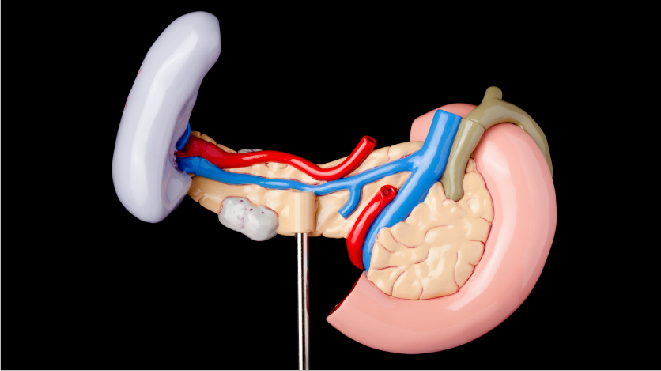The pancreas is an organ that is positioned behind the stomach. Pancreatic cancer develops when the cells in the pancreas start dividing beyond control. Abnormal growth of cancer cells in the pancreas leads to pancreatic cancer. Pancreas contains two types of cells mainly:

-
Exocrine cells:
These cells produce enzymes that help in digestion of food in the intestines. They are contained in ducts. They occupy the maximum of the pancreas.
-
Endocrine cells:
These are the minority cells in the pancreas. They produce hormones like insulin and glucagon directly into the blood. They are contained in small clusters called islets.
Pancreatic cancer can be classified according to where the tumour is and the type of cell the cancer starts from. Pancreatic tumours are of two types – pancreatic endocrine tumours and pancreatic exocrine tumours. The diagnosis, treatment and side effects are different for the different types.
Pancreatic Exocrine Tumors:
Most pancreatic cancers are exocrine tumours the cancers start in the cells which produce digestive enzymes. It can be further divided into subtypes as follows:
Pancreatic adenocarcinoma:
It is one of the most common pancreatic cancers. 9 out of 10 exocrine tumours are adenocarcinoma. It starts in the lining of the pancreatic duct, where the cells that produce the digestive enzymes are present.
Symptoms of pancreatic adenocarcinoma:
- Abdominal pain
- Diarrhea
- Bleeding
- Fatigue
- Loss of appetite
- Change in stool
Other Exocrine Tumors:
- Acinar cell carcinoma: This is a very rare pancreatic cancer. Some tumours cause excessive production of lipase, which results in this cancer.
- Intraductal papillary-mucinous neoplasm (IPMN): This tumour grows from the main duct or from the side branches of the duct. Initially during diagnosis it is not often recognized as cancer. But there is very high risk when the tumour starts to grow in the pancreatic duct.
- Mucinous cystadenocarcinoma: These are cysts that contain thick fluid present in the tail of the pancreas.
Treatment:
Following are the procedures used in treating exocrine pancreatic cancer:
- Chemotherapy
- Radiotherapy
- Surgeries to remove tumours
- Palliative care
- Pancreatectomy
Pancreatic endocrine cancer:
It is also known as pancreatic neuroendocrine tumors or islet cell tumours. It is a very rare cancer. These grow slower than the exocrine glands. They begin in the endocrine pancreas which produces insulin and other hormones. Following are the types:
Insulinoma:
It is a tumour of the pancreas caused due to deprivation of beta cells and hence secretes insulin. It is a rare form of cancer. They exclusively grow at their origin.
Glucagonoma:
This tumour forms in the cells that produce glucagon. They are generally present in the tail of the pancreas. This phenomenon occurs when the glucagon hormone secretes excessive glucose.
Gastrinoma:
It is a tumour in the pancreas caused due to the excessive secretion of gastrin which leads to ulceration in the stomach and small intestine.
Somatostatinoma:
It is a very rare tumour that develops in the delta islet cells. The tumour leads to excessive secretion of somatostatin hormone. This prevents the secretion of other hormones.
VIPomas:
This tumour releases a hormone that triggers the release of other hormones called vasoactive intestinal peptides, most of which are cancerous.
Treatment:
The following are the procedure used to treat endocrine pancreatic cancer:
- Chemotherapy
- Radiotherapy
- Surgeries to remove tumours
- Pancreatectomy
- Palliative care



